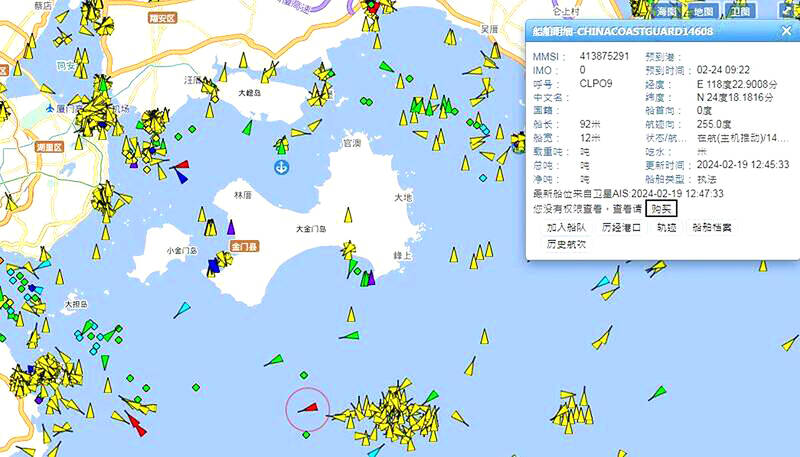Taiwanese tourists on board a Kinmen cruise ship had a scare yesterday when it was intercepted by Chinese coast guards who forcefully boarded the vessel to inspect it.
The Sunrise, a tourism ferry that operates between Kinmen and Xiamen, China, was sailing around the waters around the islets of Dadan (大膽) and Erdan (二膽) — both of which are part of Kinmen County — yesterday afternoon when it encountered personnel from China’s Fujian Coast Guard Bureau.
China Coast Guard personnel forced their way on board and conducted an inspection for about 30 minutes before leaving, local media cited the tourists as saying.

Photo: screen grab from the China Ports Web site
The Coast Guard Administration’s (CGA) Kinmen-Matsu-Penghu Branch received a report about the intrusion and dispatched two vessels to the site and escorted the ferry back to Kinmen at about 5pm, local media reported.
The Sunrise had about 20 tourists on board. Several passengers told local media they were scared they would not be able to come back to Taiwan.
The CGA called on China to uphold peace and rationality and jointly maintain tranquility in the waters around Xiamen and Kinmen. At the same time, it also reminded Taiwanese operators to avoid going near Chinese waters when engaging in maritime-related activities.
The Maritime and Port Bureau, meanwhile, said the move undertaken by China was inconsistent with international norms.
The incident came as several Chinese patrol boats yesterday morning began operating off the coast of outlying Kinmen County, days after Beijing declared it did not recognize the waters as “prohibited” or “restricted.”
China Coast Guard vessels were navigating in waters to the east, southeast and south of the main island of Kinmen, with the smallest one being 15m long and the largest 92m, ship tracking data on the China Ports Web site showed.
At 11:15am, four ships were on duty, ranging in length from 24m to 92m.
The move cane after a speedboat from China’s Fujian Province capsized off the east coast of Kinmen on Wednesday last week while it was being pursued by Taiwanese authorities. Two of the four people on board died.
Taiwan’s coast guard had pursued the speedboat because it had entered restricted waters around Kinmen and refused an inspection.
China Coast Guard spokesperson Gan Yu (甘羽) on Sunday said the Fujian Coast Guard Bureau would enhance maritime law enforcement and carry out routine patrols in waters near Xiamen and Kinmen to “safeguard order in pertinent maritime regions and guarantee the safety of fishing crews’ lives and property.”
On Saturday, China’s Taiwan Affairs Office said “fishermen on both sides of the Taiwan Strait have been operating in traditional fishing areas around Xiamen and Kinmen since ancient times.”
It rejected the existence of “prohibited” or “restricted” waters as defined by Taiwan.
Taiwan on Sunday said that under Taiwanese law, it has the right to expel or detain vessels that trespass into its “restricted” or “prohibited” waters.
Democratic Progressive Party (DPP) Legislator Wang Ting-yu (王定宇) said that China’s refusal to acknowledge the “restricted” or “prohibited” waters around Taiwan showed that it was attempting to unilaterally invalidate the Republic of China’s sovereignty.
DPP Legislator Hsu Chih-chieh (許智傑) said “China should make a return to past norms ... and not undermine cross-strait relations.”
Additional reporting by Hsieh Chun-lin

The combined effect of the monsoon, the outer rim of Typhoon Fengshen and a low-pressure system is expected to bring significant rainfall this week to various parts of the nation, the Central Weather Administration (CWA) said. The heaviest rain is expected to occur today and tomorrow, with torrential rain expected in Keelung’s north coast, Yilan and the mountainous regions of Taipei and New Taipei City, the CWA said. Rivers could rise rapidly, and residents should stay away from riverbanks and avoid going to the mountains or engaging in water activities, it said. Scattered showers are expected today in central and

COOPERATION: Taiwan is aligning closely with US strategic objectives on various matters, including China’s rare earths restrictions, the Ministry of Foreign Affairs said Taiwan could deal with China’s tightened export controls on rare earth metals by turning to “urban mining,” a researcher said yesterday. Rare earth metals, which are used in semiconductors and other electronic components, could be recovered from industrial or electronic waste to reduce reliance on imports, National Cheng Kung University Department of Resources Engineering professor Lee Cheng-han (李政翰) said. Despite their name, rare earth elements are not actually rare — their abundance in the Earth’s crust is relatively high, but they are dispersed, making extraction and refining energy-intensive and environmentally damaging, he said, adding that many countries have opted to

SUPPLY CHAIN: Taiwan’s advantages in the drone industry include rapid production capacity that is independent of Chinese-made parts, the economic ministry said The Executive Yuan yesterday approved plans to invest NT$44.2 billion (US$1.44 billion) into domestic production of uncrewed aerial vehicles over the next six years, bringing Taiwan’s output value to more than NT$40 billion by 2030 and making the nation Asia’s democratic hub for the drone supply chain. The proposed budget has NT$33.8 billion in new allocations and NT$10.43 billion in existing funds, the Ministry of Economic Affairs said. Under the new development program, the public sector would purchase nearly 100,000 drones, of which 50,898 would be for civil and government use, while 48,750 would be for national defense, it said. The Ministry of

UNITED: The other candidates congratulated Cheng on her win, saying they hoped the new chair could bring the party to victory in the elections next year and in 2028 Former Chinese Nationalist Party (KMT) lawmaker Cheng Li-wun (鄭麗文) yesterday won the party’s chair election with 65,122 votes, or 50.15 percent of the votes. It was the first time Cheng, 55, ran for the top KMT post, and she is the second woman to hold the post of chair, following Hung Hsiu-chu (洪秀柱), who served from 2016 to 2017. Cheng is to succeed incumbent Eric Chu (朱立倫) on Nov. 1 for a four-year term. Cheng said she has spoken with the other five candidates and pledged to maintain party unity, adding that the party would aim to win the elections next year and